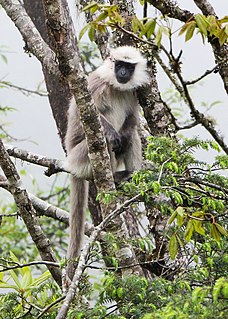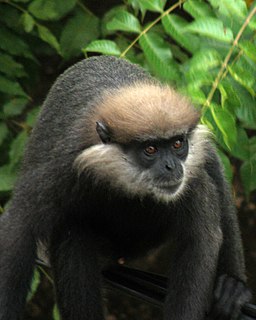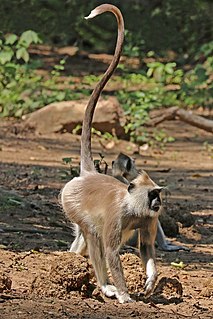 W
WThe Gray langur (Semnopithecus), also called the Hanuman langur or Hanuman monkey, is a genus of Old World monkeys native to the Indian subcontinent. Traditionally only one species Semnopithecus entellus was recognized, but since about 2001, additional species have been recognized. The taxonomy has been in flux, but currently eight species are recognized.
 W
WThe black-footed gray langur is an Old World monkey, one of the species of langurs. This, like other gray langurs, is a leaf-eating monkey found in south India.
 W
WThe Kashmir gray langur is an Old World monkey, one of the langur species. It is a leaf-eating monkey.
 W
WThe Nepal gray langur is a gray langur endemic to the Himalayas in Nepal, far southwestern Tibet, northern India, northern Pakistan, Bhutan and possibly Afghanistan. It is found in forests at an elevation of 1,500 to 4,000 metres. Its easternmost limit in India is Buxa Tiger Reserve in northern West Bengal, at least up to the Rydak river.
 W
WThe Nilgiri langur is a langur found in the Nilgiri Hills of the Western Ghats in South India. Its range also includes Kodagu in Karnataka, Kodayar Hills in Tamil Nadu, and many other hilly areas in Kerala and Tamil Nadu. This primate has glossy black fur on its body and golden brown fur on its head. It is similar in size and long-tailed like the gray langurs. Females have a white patch of fur on the inner thigh. It typically lives in troops of nine to ten monkeys. Its diet consists of fruits, shoots and leaves. The species is classified as vulnerable due to habitat destruction and poaching for its fur and flesh, the latter believed to have aphrodisiac properties.
 W
WThe northern plains gray langur, also known as the sacred langur, Bengal sacred langur and Hanuman langur, is a species of primate in the family Cercopithecidae.
 W
WThe purple-faced langur, also known as the purple-faced leaf monkey, is a species of Old World monkey that is endemic to Sri Lanka. The animal is a long-tailed arboreal species, identified by a mostly brown appearance, dark face and a very shy nature. The species was once highly prevalent, found in suburban Colombo and the "wet zone" villages, but rapid urbanization has led to a significant decrease in the population level of the monkeys. It had traditionally been classified within the lutung genus Trachypithecus but was moved to the genus Semnopithecus based on DNA evidence indicating that is it more closely related to the gray langurs.
 W
WSouthern plains gray langur was the common name ascribed to Semnopithecus dussumieri by Mammal Species of the World in 2005. Along with several other Semnopithecus, it had been previously considered a subspecies of the northern plains gray langur, Semnopithecus entellus, i.e., Semnopithecus entellus dussumieri. Subsequent genetic research has revealed that Semnopithecus dussumieri is an invalid taxon. These monkeys live in groups in forests and other rural habitats, with some groups being habituated to human contact and feeding. They are herbivorous, feeding by day mainly on foliage, fruits and flowers, and sleeping at night high in a tree.
 W
WThe Tarai gray langur is an Old World monkey, and was formerly considered a subspecies of the northern plains gray langur. The species is listed as Near Threatened, as there are probably not many more than 10,000 mature individuals, and it is experiencing a continuing decline.
 W
WThe tufted gray langur, also known as Madras gray langur, and Coromandel sacred langur, is an Old World monkey, one of the species of langurs. This, like other gray langurs, is mainly a leaf-eating monkey. It is found in southeast India and Sri Lanka. It is one of three Semnopithecus species named after characters from The Iliad, S. hector and S. ajax being the others. In Sinhala it is known as හැලි වදුරා.
 W
WThe western purple-faced langur, also known as the north lowland wetzone purple-faced langur, is a subspecies of purple-faced langur endemic to Sri Lanka. It lives in the wet zone in western Sri Lanka around the former capital city of Colombo. The subspecies is generally gray-brown with lighter whiskers, a gray rump patch, and dark forearms and legs. Typical length is between 48 and 67 centimetres excluding tail, with a 59 to 85 centimetres tail. On average, males weigh 8.5 kilograms (19 lb) and females weigh 7.8 kilograms (17 lb).